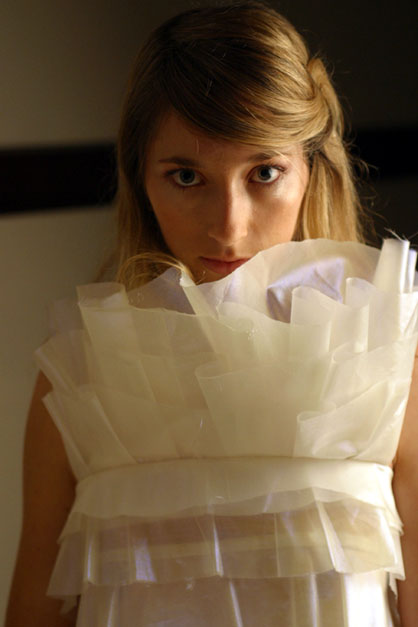|
|
||||
| home > in a bit | ||||
| Techno
Rococo: A Collaboration Amanda Salud-Gallivan |
||||
|
On November 7th 2003, The Indie Collective Couture Department presented
its Spring-Summer 2004 collection in Los Angeles. Two hundred guests
comprised mostly of local architects and designers were treated to the
fruit of Gulbin Yaviz and Elena Manferdini's serendipitous pairing.
Entitled Techno Rococo, this diaphanous debutante ball featuring
a pulsing video sea life background accompanied by glass harmonicas
celebrated an ingénue spirit born of established tradition and current
technology. Contrasting the megalomaniac fervor of Charles Rennie Mackintosh
or Adolf Loos' flirtations with fashion design, Techno Rococo
is rooted in genuine boy-meets-girl collaboration complete with earnest
adolescent energy and charming awkwardness. |
[22feb2004] | |||
 Voyeur dress with wrap top. 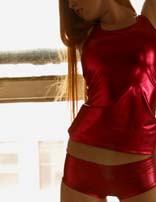 Microshorts and top in red lame. |
|
|||
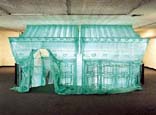 Do-Ho Suh's, Seoul Home / L.A. Home / New York Home / London Home. Silk. Credit: http://nyartsmagazine.com. |
The
roster of successful fashion designers originally trained as architects
include Gianfranco Ferré, Pierre Cardin and Tom Ford. Conversely, numerous
fashion designers regularly credit the architecture's influence on their
work; Hussein Chalayan, Issey Miyake, Rei Kawakubo and Martin Margiela
and Yohji Yamamoto, to name just a few architecture community favorites.
Now, with today's great branding and lifestyle motive pairing signature
architects with established or renaissance fashion houses, forensic
scrutiny is again directed toward the architecture/fashion symbiosis. This modestly scaled project distills its own experiment collapsing architect and fashion designer into a single event product due a backer and client. The result is the metaphorical opposite of artist Do-Ho Suh's work. Where Suh sculpts architecture-scaled spaces out of fabric using traditional tailoring, Manferdini and Yavuz make clothing by re-appropriating techniques that are still being tested and tweaked for architectural design applications. Yavuz and Manferdini first decided to work together amidst the exhibition opening regalia for Master form-maker Frank O. Gehry at Los Angeles' Museum of Contemporary Art. Yavuz, an accomplished costumer/stylist and photographer with a vehicle already in place, invited Manferdini to join her in designing and producing what became a 16 piece collection backed by the Los Angeles couture boutique, Naked. Trained as both an architect and engineer, Manferdini boasts all the digitally-driven design savvy warranted by her Greg Lynn FORM pedigree. 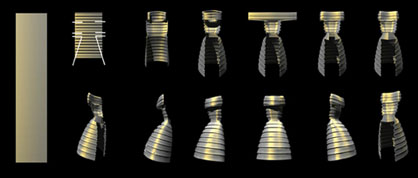 Animation of Scarab evoloving out of a plane. Complementing Yavuz' sartorial repertoire, Manferdini brought to the table 3D modeling and animation techniques she'd honed within a professional architectural and product design context. Initial computer-based form generating sessions characterize the early stages of their process. It is within these sessions that the value of Techno Rococo's technological contribution is concentrated.  Scarab dress. The collection was conceived in the gray Cartesian space of a software program, without sketch or shred of fabric in sight much less a yard to drape for tactile inspiration. Digital animations chronicle simple platonic geometry transforming to accommodate the form of the human figure via a series of intermediate operations; folding, stretching, slicing, etc. The dress later named Scarab, for example, was generated from a plane. |
|||
|
Though
beautifully reminiscent of Nanni Strada's analog 1974 Pantysol Diagrams
(wherein the Milanese designer described methods of slicing a continuous
tube resulting in a seamless bodysuit) the animations alone lack the
credibility of a traditional dressmakers' muslin mock-up. Recognizing
this, the duo elaborated pieces in real life. The draped studies showed
promise in their fidelity to the computer models on which they were
based. Fabrics were not cut, for example, on the bias or diagonal to
the grain; the resulting surface behavior would have been infinitely
more complicated to control in the 3D model. Finally, using a variant
of current manufacturing techniques, the pair extracted three-dimensional
digital information out of software to produce the sample-sewer's flat
pattern. Selecting fabrics halted the trajectory toward the ultra-stoic that computer-varied-form and cutting aplomb might have suggested. Stark black and neutral taupe died with the muslin studies; the finished samples were rendered in iridescent candy colored taffeta. 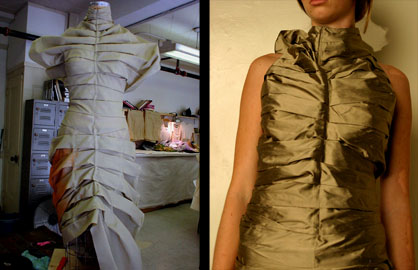 Muslin mock-up of "vertebrate" dress, and final Vertebra dress. Bias cut tops and micro-shorts in curve-hugging gold and red lame were eventually introduced as a counterpoint to the more elaborate pieces, hinting the start of comprehensive production design. Instinctively, the designers responded to the 'branding' call which would involve venue selection, lighting, video, press material and the composition of musical accompaniment; all elements with which fashion design is routinely accustomed and architecture is, for better or worse, beginning to adapt. From a contemporary perspective, the work of Belgian architect and designer, Henry van de Velde, might be viewed as a turn-of-the century lifestyle/branding exercise. Where Van de Velde's social agenda concentrated his efforts on the domestic environment, Techno Rococo mines from the urban environment. Techno Rococo gains strength and innate social cause by sampling and mixing disciplines. Amanda Salud-Gallivan |
 One of Nanni Strada's Pantysol Diagrams. |
|||
| Techno
Rococo The clothing line has been designed by Indie Collective principal, Gulbin Yavuz and the design architect, Elena Manferdini. The original soundtrack and video projections for INDIE COLLECTIVE catwalks is produced by the Defectikons (Justin Lui, Chris McCullough, Shaheen Seth). All images are courtesy of IndieCollective. No copyright associated. Photo: Greg Greensaw Make up: Kelly Kuhn Models: Kristin Barrel and Nicole Hasler |
||||
|
Elena Manferdini is the principal of Atelier Manferdini, an architectural
office that specialize in the cutting edge of computer-aided design
of exotic forms. Because of her combination of degrees in engineering
and architecture, Elena Manferdini's practice applies construction and
manufacturing technologies from the aeronautic and car industry to the
field of architecture, object design and fashion. Her work has received
numerous awards and has been exhibited internationally in both architecture
and art museums. Elena Manferdini was a member of United Architects
team with whom she has participated in the Site Design Competition for
Ground Zero and entered the short list for the World Trade Center final
proposal. Elena Manferdini has also written and lectured on architectural
design and theory. She is currently teaching at the Graduate Level Program
at the Southern California Institute of Architecture and has previously
taught at UCLA. Gulbin Yavuz is the principal of Indie Collective, a Los Angeles based fashion design-company founded in 1999. Indie Collective was born from an experimental fusion between multi-disciplinary art and apparel, and has become an incubator for diverse creative talents to spring from. During her career as a costume designer/stylist she has collaborated with brilliant film directors including Alex Proyas, Michel Gondry, Peter Care and Mark Romanek. Parallel to her fashion designer practice, Gulbin Yavuz is also a photographer; her work has been exhibited in a solo show and numerous group exhibitions. The DEFECTIKONS use architectural methods and media techniques to create and transform physical spaces. Chris McCullough, Shaheen Seth and Justin Lui met at the Carleton University School of Architecture in Ottawa, Canada in 1993, where they first collaborated projecting video and DJing at house parties and school events. Upon graduation, the DEFECTIKONs lived and worked separately in Osaka, New York and Ottawa before re-forming in 2000 in Los Angeles. Recent DEFECTIKON performances include video-music installations for the IFVA independent film festival opening night, the Afterhours/Aftertaste/Aftershock series of art events, and a DJ set at the opening of the Frank Gehry exhibit at MOCA. They are currently working on an EP of original music, a mix album, new videos and are collaborating with clothing designers on several websites. Amanda Salud-Gallivan received a Bachelors Degree in Architecture at the University of Illinois Champain-Urbana and a Masters Degree from UCLA. She now works and lives in Los Angeles, California. |
||||
|
Per
qualsiasi comunicazione laboratorio
|
